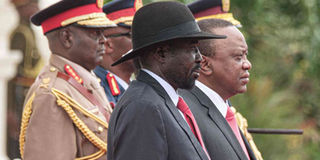Will Kenya’s land offer to South Sudan bear fruit?

Presidents Salva Kiir (South Sudan) and Uhuru Kenyatta (Kenya) during the former's welcome ceremony at State House in Nairobi on July 1, 2019. PHOTO | YASUYOSHI CHIBA | AFP
What you need to know:
- This past Monday, President Kenyatta offered 10 acres to South Sudan President Salva Kiir to build an inland container depot, to promote trade between the two countries.
- In March, President Kenyatta also offered Ugandan President Yoweri Museveni some land in the same area to build a dry port for the country’s cargo.
- Chris Onyango, an expert on international matters, said President Kenyatta’s use of land to entice trade partnership is not unique.
- Dr Onyango said allowing neighbours to set up dry ports has other benefits including decongesting Mombasa port and transferring the burden of logistical efficiency.
President Uhuru Kenyatta has once again offered a neighbouring country a piece of land at the standard gauge railway terminal in Naivasha.
This past Monday, President Kenyatta offered 10 acres to South Sudan President Salva Kiir to build an inland container depot, to promote trade between the two countries.
“To ease the movement of consignments, the government has responded to the request by South Sudan to set aside 10 acres of land at the Naivasha dry port,” he said when he hosted the South Sudanese leader, who was on a two-day state visit.
The heads of State held talks on the restoration of peace and stability in South Sudan, trade ties, and the implementation of regional integration projects, especially the Lamu Port-South Sudan-Ethiopia Transport (Lapsset) corridor, East Africa's largest and most ambitious infrastructure project.
In March, President Kenyatta also offered Ugandan President Yoweri Museveni some land in the same area to build a dry port for the country’s cargo.
SGR FUNDING
Kenya has been seeking business for the SGR in an effort to increase the flow of cargo as it continues to service a heavy Chinese debt.
Uncertainty shrouds the expansion of the SGR to neighbouring countries, as funding for the additional lines has halted.
Kenyan and Ugandan officials have expressed optimism that funding will come through for the line to Kampala, especially after holding talks with Chinese officials and Exim Bank at the Forum on China-Africa Co-operation meeting in Beijing late last month.
In its first year of operation, the SGR from Mombasa to Nairobi made Sh5.7 billion ($57 million), against an annual operating cost of Sh12 billion ($120 million).
PUBLIC DEBT
China is a leading external lender to Kenya, with public debt standing at Sh5.6 trillion ($56 billion), according to the National Treasury.
Kenya owes China nearly Sh560 billion ($5.6 billion), of which Sh323 billion ($3.23 billion) is the SGR loan (less the 3.6 per cent interest).
A report compiled by the Institute of Economic Affairs notes that Kenya is struggling to keep its mega projects viable — like the Lamu Port-South Sudan-Ethiopia-Transport (Lappset), the SGR and major highways.
“The viability question is critical. The government wants to prove the value for money of the investments in the wake of rising debt servicing charges,” IEA said.
'NOT UNIQUE'
Chris Onyango, an expert on international matters, said President Kenyatta’s use of land to entice trade partnership is not unique.
“Land is a short-term tool used to secure long-term partnership for sustainable use of the Mombasa port. It can also facilitate clearance of goods destined to those countries,” he said.
Other than the Chinese loan, there is a bigger threat that could render the SGR redundant. A modern railway is being built in the Central Corridor from Tanzania to Central Africa.
Tanzania President John Magufuli is wooing Rwanda, Burundi, the Democratic Republic of Congo and South Sudan to use the line when it is complete. Uganda could hop onto the Central Corridor as well if it proves to be convenient for its goods.
Tom Mboya, an international relations and diplomacy lecturer at Maseno University, said President Kenyatta is rushing against time to lock South Sudan and Uganda to the Northern Corridor so that they don’t look south.
“President Kenyatta’s land incentive seeks to attract business and maximise the SGR. Bringing these countries on board is a wise decision. In a world of competition, we bring our enemies closer and maintain existing relationships,” said Mr Mboya.
SGR LOSSES
The SGR continues to make losses despite efforts by the government through its key agencies, Kenya Railways and Kenya Ports Authority, to give users incentives through low fares for most of last year, and policies to coerce importers to use the cargo services.
The Chinese cited the losses as the reason why they were hesitant to finance the onward construction of the railway from Naivasha to Kisumu and Malaba. They claimed they had not been assured of repayment of the debt.
The initial plan was to have trains deliver cargo inland and back to the port. However, many trains now go back to Mombasa with empty containers.
Concerns have also been raised about the benefits to Kenya from the land incentives, considering that the economies of South Sudan and Uganda are relatively small.
South Sudan’s economy is still taking a beating from a conflict that has led to a negative growth rate of -6.3 per cent in 2017, and inflation rates at 104 per cent according to the African Development Bank.
Uganda, despite having secured the land, did not factor in allocation for the construction of a dry port in its budget for the financial year 2019-2020.
Dr Onyango said allowing neighbours to set up dry ports has other benefits including decongesting Mombasa port and transferring the burden of logistical efficiency.




